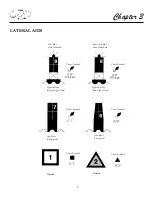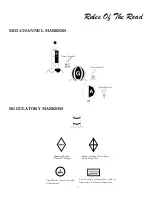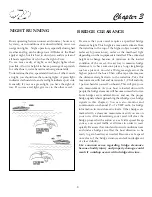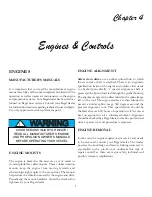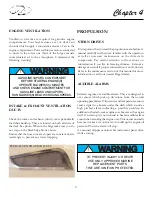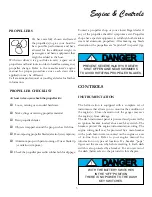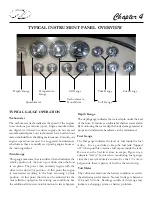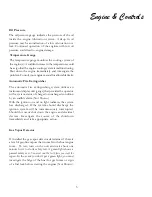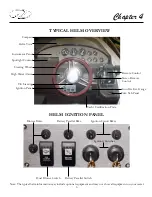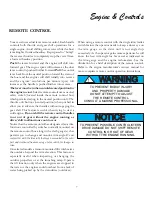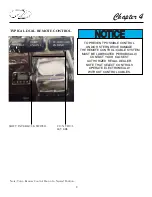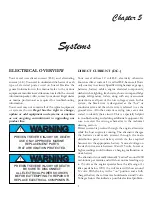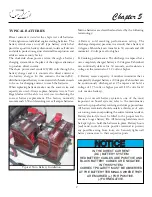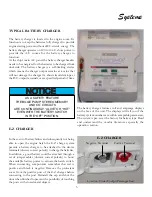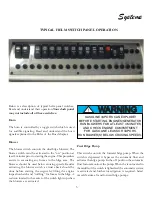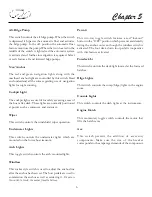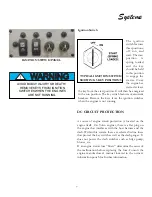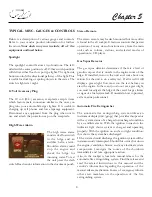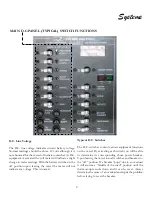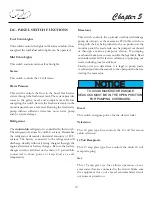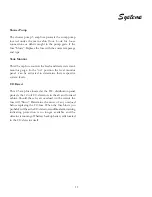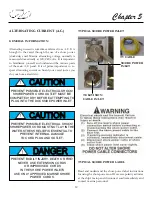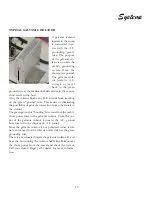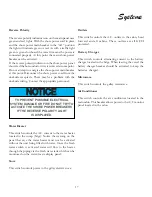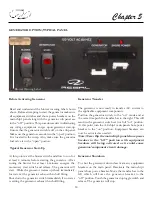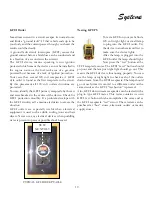
4
Chapter 5
TYPICAL D.C. DISTRIBUTION CENTER
Your vessel features on-off style battery switches. The
battery switches control both the house and dual engine
battery circuits. With the two battery system, one battery
serves a dual purpose for both house uses and engine
starting.
Never turn the battery switch to the “off ” position
with the engine running as it could cause engine
alternator or charging system damage.
Upon leaving the vessel it is recommended that the battery
switch be turned to the “off ” position. For security
purposes this will deactivate both engines and the related
house circuits but the automatic bilge pump, carbon
monoxide detectors and the stereo memory circuits will
operate as normal.
There may be times when you want to charge up both
boat batteries while at dockside. To accomplish this, install
the dockside cord at the boat first. Then plug the dockside
cord into the marina 30 amp service fitting. Twist lock
both ends into the inlets. Turn on the breaker if applicable
at the dockside service side. Make sure the dockside cord
is not dangling in the water but has enough slack if in a
tidal area. Activate the breaker at the boat shore power
inlet.
Energize the shore power 30 amp breaker on the ship’s
main A.C./D.C. panel. Approximately 120 volts should
display on the ship’s panel A.C. volt meter along with the
green light on the ship’s panel.
CAUTION
!
AVOID POSSIBLE FIRE
AND/OR EQUIPMENT DAMAGE.
DO NOT TURN THE BATTERY SWITCHES
TO THE “OFF” POSITION
WITH THE ENGINE RUNNING.
At this point flip on the battery charger breaker to energize
the battery charging process.
Combine Batteries-
By using the battery parallel
momentary toggle switch located on the dash both batteries
are combined to crank the engine in lieu of a weak single
engine battery.
Important Battery Switch Operation Information
Port Battery Switch-
controls port engine, windlass and
helm electronics.
Starboard Battery Switch-
controls starboard engine,
dash main, cabin main, generator option and E-Z charger.
Summary of Contents for 30 EXPRESS
Page 1: ...30 EXPRESS OWNER S MANUAL...
Page 2: ...784022 OWNER S MANUAL 30 EXPRESS 12 2012...
Page 30: ...11 Safety On Board NAVIGATION LIGHT RULES...
Page 41: ...Chapter 2 22 Notes...
Page 44: ...3 Rules Of The Road NAVIGATION RULES...
Page 85: ...28 Chapter 5 Notes...
Page 105: ...4 Chapter 7...
Page 106: ...5 Equipment Operation...
Page 107: ...6 Chapter 7...
Page 108: ...7 Equipment Operation...
Page 109: ...8 Chapter 7...
Page 110: ...9 Equipment Operation...
Page 111: ...10 Chapter 7...
Page 117: ...16 Chapter 7...
Page 126: ...25 Equipment Operation ROTARY ENCODER AND MENU KEY...
Page 127: ...26 Chapter 7 USING THE ROTARY ENCODER AND MENU KEY...
Page 158: ...57 Equipment Operation BACKING A TRAILER 1 2 3 4 LAUNCHING RAMP...
Page 161: ...60 Chapter 7 Notes...
Page 195: ...34 Chapter 8 Notes...
Page 204: ...9 Troubleshooting TOILET SYSTEM DIAGNOSTIC CHART...
Page 209: ...14 Chapter 9...
Page 219: ...6 Chapter 11 Notes...
Page 221: ...2 Chapter 12...
Page 224: ...5 Technical Information 30 Express Deck Overview 30 Express Cabin Overview...
Page 225: ...Technical Information 12 6 30 EXPRESS...
Page 226: ...12 7 Technical Information 30 EXPRESS...
Page 227: ...Technical Information 12 8 30 EXPRESS...
Page 228: ...12 9 Technical Information 30 EXPRESS...
Page 229: ...Technical Information 12 10 30 EXPRESS 30 EXPRESS...
Page 230: ...12 11 Technical Information TYPICAL NEGATIVE GROUND SYSTEM...
Page 231: ...Technical Information 12 12 30 EXPRESS...
Page 232: ...12 13 Technical Information 30 EXPRESS...

